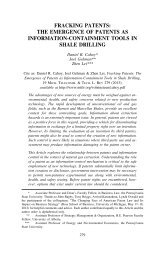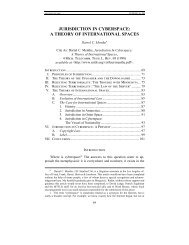the chinese regulatory licensing regime for pharmaceutical products
the chinese regulatory licensing regime for pharmaceutical products
the chinese regulatory licensing regime for pharmaceutical products
You also want an ePaper? Increase the reach of your titles
YUMPU automatically turns print PDFs into web optimized ePapers that Google loves.
442 Michigan Telecommunications and Technology Law Review [Vol. 15:417<br />
NDC. 142 This similarity demonstrates that China has adopted an approach<br />
similar to many o<strong>the</strong>r developed countries, such as <strong>the</strong> United States,<br />
where <strong>the</strong> importation of drugs is generally subject to <strong>the</strong> same controls<br />
as <strong>the</strong> marketing of domestic drugs. 143 For convenience, I refer to this<br />
approach as <strong>the</strong> “reassessment procedure.”<br />
In contrast, o<strong>the</strong>r countries adopt an alternative approach to <strong>the</strong> reassessment<br />
procedure: developing countries in particular “tend to be<br />
guided by registration decisions made in <strong>the</strong> country where <strong>the</strong> drug is<br />
manufactured or in countries where <strong>the</strong> drug is used.” 144 Under this approach,<br />
<strong>the</strong> importing countries base <strong>the</strong>ir <strong>licensing</strong> decisions on <strong>the</strong><br />
in<strong>for</strong>mation supplied by <strong>the</strong> <strong>licensing</strong> authority in <strong>the</strong> exporting countries<br />
concerning <strong>the</strong> safety, efficacy and quality of <strong>the</strong> drugs, ra<strong>the</strong>r than<br />
on clinical trials or o<strong>the</strong>r tests carried out in <strong>the</strong> importing countries. I<br />
refer to this approach as <strong>the</strong> “recognition procedure.” A typical example<br />
of <strong>the</strong> recognition procedure is <strong>the</strong> World Health Organization (WHO)<br />
Certification Scheme on <strong>the</strong> Quality of Pharmaceutical Products Moving<br />
in International Commerce. 145 Ano<strong>the</strong>r example is <strong>the</strong> harmonization and<br />
mutual recognition of drug <strong>licensing</strong> decision-making among EU member<br />
states. 146<br />
Because China has adopted <strong>the</strong> reassessment procedure, <strong>the</strong> analyses<br />
regarding <strong>licensing</strong> procedures to obtain an NDC can also be generally<br />
regarded as applying to <strong>the</strong> procedures to obtain an RCID. My analysis<br />
142. RCIDs and NDCs have two main distinctions. First, <strong>for</strong> imported drugs, <strong>the</strong> SFDA<br />
is responsible <strong>for</strong> <strong>the</strong> initial inspection of <strong>the</strong> application, supporting documents, data, and<br />
samples; and <strong>the</strong> China Pharmaceutical Biological Products Testing Institute or an appointed<br />
testing institute initially examines <strong>the</strong> samples and issues a report. In contrast, <strong>for</strong> new domestic<br />
drugs, a provincial branch of <strong>the</strong> SFDA is responsible <strong>for</strong> <strong>the</strong> initial inspection of <strong>the</strong><br />
application, and its appointed testing institution initially examines <strong>the</strong> samples and issues a<br />
report. Second, unlike imported drugs, new domestic drugs are subject to a second on-site<br />
inspection and sample test organized by <strong>the</strong> DCC of <strong>the</strong> SFDA.<br />
143. See 2001 Drug Administration Law, supra note 5, art. 39; SFDA Commentary,<br />
supra note 5, art. 39.<br />
144. D. C. Jayasuriya, Regulation of Pharmaceuticals in Developing Countries:<br />
Legal Issues and Approaches 55 (WTO 1985).<br />
145. “The WHO certification scheme is an international voluntary agreement, devised to<br />
enable countries with limited drug <strong>regulatory</strong> capacity to obtain partial assurance from <strong>the</strong><br />
exporting countries concerning <strong>the</strong> safety, quality and efficacy of <strong>the</strong> <strong>products</strong> <strong>the</strong>y plan to<br />
import. The voluntary agreement requires that <strong>the</strong> <strong>regulatory</strong> authorities of exporting countries<br />
issue Certificates when requested by <strong>the</strong> importing countries . . . . [The Certificate at least can<br />
attest] whe<strong>the</strong>r a specific product is approved <strong>for</strong> use in <strong>the</strong> exporting country, or if not, why<br />
not.” World Health Organization, WHO Certification Scheme on <strong>the</strong> Quality of<br />
Pharmaceutical Products Moving in International Commerce (2000), available at<br />
http://whqlibdoc.who.int/hq/2000/WHO_EDM_QSM_2000.2.pdf. At present, China has not<br />
participated in <strong>the</strong> WHO certification scheme.<br />
146. See generally John Abraham & Graham Lewis, Europeanization of Medicines<br />
Regulation, in Regulation of <strong>the</strong> Pharmaceutical Industry 42, 42 (John Abraham &<br />
Helen Lawton Smith eds., 2003).






